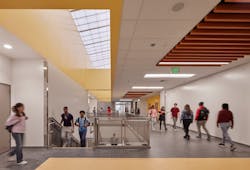Effective Commercial Daylighting Design: Supporting Comfort and Wellness
Natural light has always been an essential component of architecture. As designers, we have known that effectively integrating daylight and views into buildings make them better, more energy efficient and create better environments for the occupants within.
The problem, in years past, was providing the concrete evidence that access to daylight and views provided direct financial benefit to corporations and building owners. As a result, the benefits of daylight on occupant wellbeing, satisfaction and productivity were largely anecdotal. However, with the advancements in modern technology and the increased understanding of the effects of natural light on human physiology and wellness, daylighting has taken on a new level of importance in commercial building design.
As such, evidence-based design has been used to support the development of new rigorous building and space assessment and rating metrics relative to daylight sufficiency, such as the spatial Daylight Autonomy (sDA) and Annual Sunlight Exposure (ASE) metrics developed by the Illuminating Engineering Society (IES), and human circadian stimulation, using melanopic illumination criteria which are a different point of reference than the age-old photopic illuminance criteria used for traditional lighting design, to modern building design guidelines and standards such as the U.S. Green Building Council’s (USGBC) LEED Rating Tools and the International WELL Building Institute’s (IWBI) WELL Building Standard (WELL).
Research and evidence-based design activities show, beyond a shadow of a doubt, that providing building occupants with the artful application of daylight (as a source of interior illumination) results in improved health and happiness. With this knowledge, architects and designers are exploring new ways to incorporate daylighting into their projects, seeking to create buildings that are not only visually stunning but also support the health and wellbeing of the people who inhabit them.
Daylight and Productivity
The relationship between daylight and productivity has been well documented in recent years. Studies have shown that natural light exposure can improve sleep, reduce fatigue and enhance cognitive performance. Workers who are exposed to daylight are more alert, have fewer errors and are more productive than those who are not.
For example, a Future Workplace poll conducted for the Harvard Business Review found that 70% of people reported access to natural daylight improved their work performance. Overall, when employees are fulfilled in their workplace environment, they are more engaged, produce higher quality individual work and are much happier in general, which creates an even more enjoyable workspace.
Daylight and Wellness
Natural daylight is truly the best medicine for the office. A study by Dr. Alan Hedge, a workplace design expert and professor in the Department of Design and Environmental Analysis at Cornell University, found that workers in daylight office environments reported a 51% drop in the incidence of eyestrain, a 63% drop in the incidence of headaches and a 56% reduction in drowsiness. Hedge concluded that “As companies increasingly look to empower their employees to work better and be healthier, it is clear that placing them in office spaces with optimal natural daylight should be one of their first considerations.”
Additionally, workers with more daylight exposure in the office had longer sleep duration, better sleep quality, more physical activity and better quality of life compared to office workers with less light exposure in the workplace, reports a study from Northwestern Medicine and the University of Illinois at Urbana-Champaign.
Daylight as a Disinfectant
For decades, UV light has been utilized as a natural disinfectant for cleaning drinking water and eliminating potentially harmful organisms in health care facilities. Recently, a study published in the journal Microbiome has demonstrated that rooms exposed to daylight exhibit similar effects as UV light in reducing the number of germs present. In fact, the study revealed that daylit rooms had around half as many viable bacteria, compared to dark rooms.
In addition, daylit rooms were found to contain fewer types of bacteria that result from human skin shedding (including some that can cause respiratory disease), and more closely resembled outdoor bacterial communities. This led to the conclusion that while daylighting was previously believed to be only beneficial for visual comfort and broad health, it also influences air quality and functions as a disinfectant as well.
About the Author
Neall Digert
Neall Digert, Ph.D., MIES, Vice President, Innovation and Market Development, Kingspan Light + Air North America, has over 30 years of consulting and education experience working in the energy/lighting/daylighting design and research fields, specializing in the design and application of advanced lighting and daylighting systems for commercial building applications.

